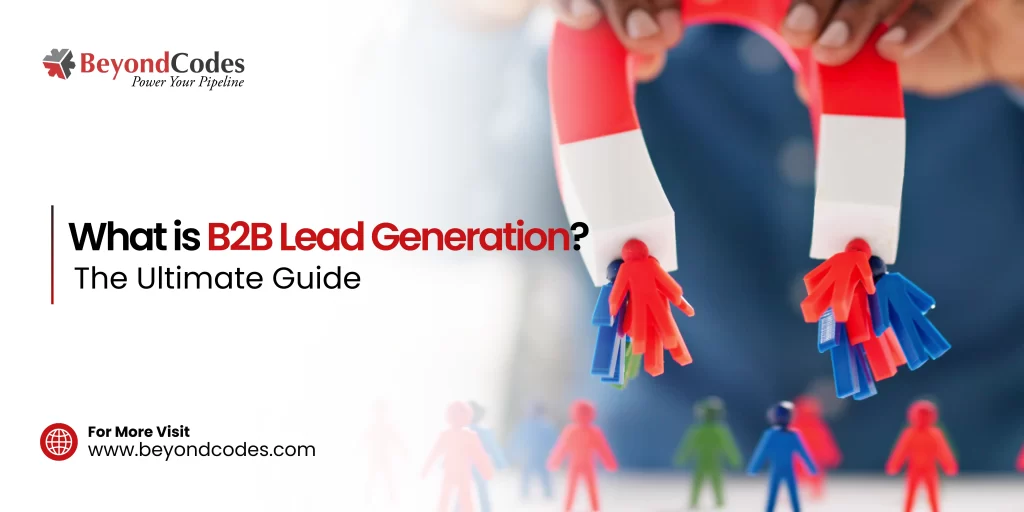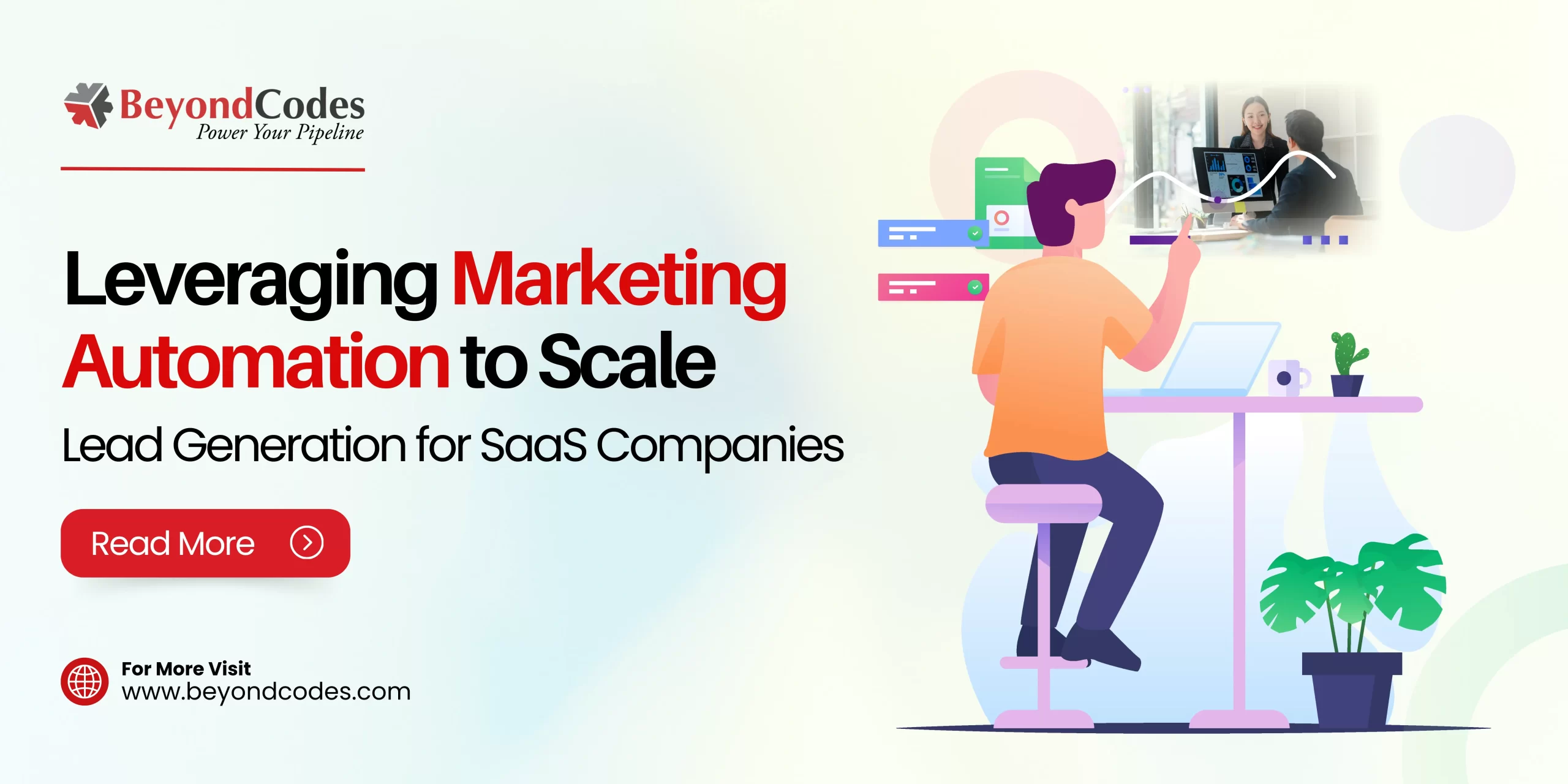Businesses often struggle to generate high-quality B2B leads to sustain in this highly competitive world. There are plenty of B2B lead generation strategies and technologies that businesses can leverage to achieve the desired goals.
But what’s the irony? No one knows the process of generating B2B leads, and without learning, they get started due to the rising competition in the industry.
Whether a newbie or a seasoned pro, B2B lead generation is the secret sauce for every business’s success. Why? Without quality leads, a company will not have the opportunity to convert prospects into clients.
In this guide, we will delve into the intricacies of B2B lead generation, covering everything from its definition and importance to strategies enabling you to master this essential aspect of advanced business marketing.
Before we dive in, let’s Check the statistics first:
50% of marketers consider lead generation a top priority in their marketing campaigns. (HubSpot)
53% of marketers spend at least half their budget on lead generation activities.
This shows that marketers are putting their money where their mouth is, making lead generation a key objective for businesses.
What is B2B Lead Generation?
B2B lead generation is the art of identifying, attracting, and converting potential clients for your business. These leads are individuals or companies interested in your products or services, making them potential clients.
The B2B lead generation process involves a range of marketing and sales activities designed to create a pipeline of B2B prospects who can be nurtured and eventually converted into paying clients. These leads can come from various sources, including your website, social media, email campaigns, etc.
But, moving further, let’s explore its significance together.
Also Read: Prospecting vs. Lead Generation: Which Method Works Best for your Sales Business
Why Is B2B Lead Generation Important?
Without lead generation, your business may struggle to attract new clients and sales possibilities. Businesses must get in touch with individuals who could get engaged in what services they are offering and help the way they want to add value. It starts from the moment a prospect visits your website, hears about your product, or word-of-mouth marketing.
For various reasons, B2B lead generation is a key factor of a successful B2B marketing strategy:
1. Improve Your Market
When you first launched the company, you certainly targeted an audience in particular. However, is this the only industry you should consider targeting? Lead generation allows you to learn more about your prospects. With a B2B lead generation strategy, you might get client or company engagement and the ability to develop into new markets.
2. Increase Your Fan Base
Communication is important for good lead generation. It includes producing high-quality content and initiating discussions by cold calling, emailing, or social media. By sharing informative content with your target audience, you can position your company as a thought leader. This way, a community of professionals will appreciate and follow your brand growth.
3. Maximize Your Profits
If done correctly, lead generation can increase your brand’s potential to reach target prospects. To attract a prospect’s interest, you only need content with the correct messaging, offer, and a good sales pitch. It will make it easy to get the interest of targeted prospects, streamlining the sales process. Focusing on client needs and pain points leads to revenue growth.
4. Enhance Lead Quality
Your content creation strategy integrates lead generation with a highly targeted approach. You must target specific clients in everything you write for your company, from the website and email texts to social media and blog posts. It improves lead quality, which, in turn, increases conversions.
For example, if we target CVD (Chiefs, Vices, or Directors) level clients, our content and sales outreach strategies must reflect their specific demands and goals. Create content or a sales pitch directly addressing their issues and goals, drawing their attention, and nurturing a relevant connection.
5. Increase Visibility and Awareness
Who doesn’t want extra eyes on their business, whether a newbie or a well-known one? It is important to increase visibility and awareness to turn the tide in your favor. You can achieve this by developing content that interests your target audience and publishing it on the platforms they use frequently.
Quick Plug: Gain access to quality leads and appointment setting by leveraging B2B lead generation services at Beyond Codes. Take the first step today to elevate your business growth like never before. Call us now!
Types of B2B Leads
B2B (business-to-business) leads are divided into several types based on many factors and attributes. Here are some examples of frequent B2B leads:
1. Marketing Qualified Leads (MQLs)
These leads have expressed an interest in your products or services by interactions with marketing efforts such as downloading a whitepaper/eBook, signing up for a newsletter, or attending a webinar. They may not be ready to buy yet, but they are worth nurturing.
2. Sales Qualified Leads (SQLs)
SQLs are MQLs that have undergone further analysis and are considered more likely to become clients. They have shown more interest in your offerings by looking for a product demo or price information.
3. Cold leads
These potential clients have not yet expressed an interest in your company but suit your ideal customer profile based on geography or industry. Outbound outreach is required to engage and convert them.
4. Warm leads
These prospects have engaged with your company but have not advanced to MQL or SQL. For example, they may have visited your website, followed your social media pages, or interacted with your content.
5. Inbound leads
These prospects found your company through organic sources, such as your website, blog, or social media. They have contacted you and are eager to learn more about your services.
6. Outbound leads
These are the prospects acquired by proactive outreach efforts such as cold calling, email campaigns, or direct mail. Outbound leads are frequently the outcome of a well-planned sales and marketing strategy.
7. Referral Leads
These valuable leads are generated by current clients, partners, or other businesses in your network. Referrals are extremely valuable because they are based on trust.
8. Strategic Account Leads
These leads are a part of account-based marketing (ABM) and represent high-value accounts or companies that match your ideal client profile. They are the focus of dedicated marketing and sales activities.
The key to good lead generation is to customize your sales approach to these varied lead categories. Each category necessitates a unique conversion strategy.
How Buyer’s Journey Works to Convert a Lead into a Sale
The process of converting a lead into a sale includes several stages in the buyer’s journey. These stages guide a potential client from initial awareness to becoming a paying client. This buyer’s journey includes the following stages:

1. Awareness
At the beginning of this journey, the prospective buyer identifies a challenge or opportunity. They realize a need or problem and seek information to understand it better.
2. Consideration
After defining the issue, the lead researches potential solutions. They explore options and gather information about how different products or services can address their needs.
3. Decision
In this phase, the lead narrows the choices and evaluates specific offerings in detail. They weigh the pros and cons, possibly engaging with demos, trials, or seeking more personalized information.
4. Purchase
Once the lead has reached a decision stage, they are moved forward to make the purchase. This step involves finalizing the transaction, signing contracts, and officially becoming a client.
Each stage of this journey provides opportunities for businesses to engage with and guide potential customers. By understanding and addressing the needs of the B2B lead at each phase, companies can effectively nurture and guide them toward making a purchase. This process often involves targeted marketing, tailored information, and personalized interactions to assist the lead in decision-making.
Key Challenges in B2B Lead Generation
While B2B lead generation has many benefits, it also has some drawbacks. Here are the challenges you might face and need to overcome:
a. Identifying Ideal Customer Profiles: It’s critical to define your ideal consumer profiles. Failing to do so can result in a dispersion of efforts and resources in B2B prospecting on leads most likely to drive conversions and maximize outcomes.
b. Content Quality: Building high-quality content is important for attracting and engaging prospects. Maintaining a consistent content strategy might be challenging.
c. Lead Nurturing: It is of the utmost importance over time. It is not enough to collect contact details; you must also deliver value and create trust through constant communication.
d. Stay Competitive: The B2B landscape is highly competitive. Understanding your competition and differentiating your offers are critical for standing out.
Effective B2B Lead Generation Strategies in Sales
Effective B2B lead generation is crucial for sales success. Here are some strategies to help you generate high-quality leads in the B2B space:
1. Understand Your Target Audience
Start by developing thorough buyer personas. Understand their pain points, needs, and preferences to customize your lead generation efforts to attract the right audience.
2. Content Marketing
Develop valuable and relevant content that addresses your target audience’s issues and queries. This information can take the form of blogs/articles, whitepapers, eBooks, webinars, or videos. To improve visibility, ensure that your content is optimized for search engines.
3. Social Media Marketing
Use platforms like LinkedIn, Twitter, and Facebook to connect with and engage potential B2B leads. To reach a larger target audience, share your content or sales pitch, participate in discussions, and use paid advertising options.
4. Email Marketing
Build and segment an email list. Use targeted email messages for B2B lead nurturing as it offers useful articles, customized sales pitches, market insights, and exclusive deals. Also, businesses can automate their email marketing to scale their sales process effectively.
5. Cold Outreach
Although it’s often considered less effective, cold outreach can work when done right. Personalize your messages, provide value in your initial contact, and follow up strategically.
6. Webinars and Workshops
Organize webinars or workshops on topics relevant to your target audience. These events not only provide value but also collect contact information from attendees.
7. Landing Pages
Build dedicated landing pages for specific products or services and use them in marketing campaigns. These pages should have a clear call to action and capture user information.
8. Content Gating
Consider gating some high-value content behind lead capture forms. It encourages visitors to provide their contact information in exchange for access to the content.
9. LinkedIn Sales Navigator
Use LinkedIn’s premium offering, Sales Navigator, to more efficiently find and engage with new leads.
10. Data Enrichment
Use data enrichment tools and services to fill in missing information about your leads. It ensures you have the most accurate and up-to-date contact details.
Also Read: 20 Highly Effective B2B Lead Generation Sales Strategies
11. Lead Scoring
Implement lead scoring to prioritize and concentrate on your efforts on the most promising leads. Consider factors like engagement, demographics, and firmographics.
12. A/B Testing
Continuously test different lead generation strategies to see which ones are most effective. It includes testing various ad copy, email subject lines, and landing page designs.
13. Sales and Marketing Alignment:
Ensure your sales and marketing teams are aligned regarding goals and strategies. Collaboration between these teams is crucial for successful lead generation.
14. Analytics and Reporting
Regularly analyze the performance of your lead generation efforts. Track your progress with tools such as social media insights, Google Analytics, and email marketing analytics.
Conclusion
Remember, effective B2B lead generation is an ongoing process. The key to success is continual review and change of your plans to match your target audience’s ever-changing wants and preferences, as well as the changing environment of your business.
And, as we’ve seen, statistics don’t lie. Lead generation is still the main goal for marketers, and companies are investing substantial amounts of money to make it happen. So, whether you’re just getting started or a seasoned pro, understanding the complicated nature of B2B lead generation is your key to flourishing in today’s competitive business market.








